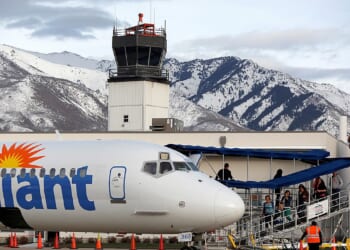Unlike the Air Force’s flashier fighter jets, the A-10 flies low and slow—and can dish out immense punishment to enemy ground forces.
The A-10 Thunderbolt II (popularly known as the “Warthog”) was designed from scratch around a singular purpose: to fly at low level and support ground troops. All of the A-10’s flight characteristics and performance envelope are tailored to the Close Air Support (CAS) mission set—making the A-10 one of the most unusual aircraft to fly in the US inventory.
The A-10 Warthog’s Specifications
Year Introduced: 1977
Number Built: ~716 (all variants)
Length: 53 ft 4 in (16.16 m)
Wingspan: 57 ft 6 in (17.42 m)
Weight (MTOW): ~51,000 lb (23,132 kg)
Engines: Two General Electric TF34-GE-100 turbofans (~9,000–9,275 lbf thrust each)
Top Speed: ~420 mph (675 km/h)
Range: Combat radius ≈ 290 nmi (334 mi, 537 km); ferry range with tanks ~2,200 nmi (2,532 mi, 4,074 km)
Service Ceiling: ~45,000 ft (13,700 m) — tactical employment almost always near ground level
Loadout: GAU-8/A 30 mm rotary cannon (centerline); up to ~16,000 lb (7,260 kg) of external stores; loadout can include AGM-65 Mavericks, rocket pods, 2.75″ rockets/APKWS, JDAM/GBU kits, gun pods, flares/chaff, external tanks
Aircrew: 1 (pilot)
The A-10 Warthog: Low and Slow
The A-10’s handling is forgiving and predictable. Designers outfitted the aircraft with a large wing and relatively low wing loading, resulting in high lift at modest speeds and a low stall margin—ideal for the “low and slow” flight requirements of CAS missions. The result is stability in slow flight and a responsiveness at low speeds, which other aircraft lack, making the A-10 relatively easy to fly while freeing up the pilot’s attention for the target acquisition and weapons delivery required of CAS. Further, the A-10’s solid control authority at low speeds allows for operations from austere forward strips, an ability that has made the A-10 increasingly valuable through years of providing direct support to troops in contact, anywhere in the world.
Obviously, the A-10 lacks the flash of its contemporaries; the aircraft is neither fast nor stealthy; The A-10 will neither outrun nor out climb adversary fighters. But these were intentional design tradeoffs. The A-10 was outfitted with twin TF34 turbofan engines, which produce only modest thrust compared to fighter engines. When the TF34s are combined with the A-109’s heavy armored structure and large payload capacity, the result is an aircraft with a top speed well below the speed of sound—rare for modern military single-seaters. But speed was never the objective with the A-10. And the A-10’s relatively low speed is offset with long-loiter endurance and heavy payload—attributes which give the A-10 the persistence necessary for CAS.
How a Close Air Support Mission Works
Maneuvering and energy management is where the A-10’s design specifications really make an effective difference. CAS operations require the preservation of workable energy states rather than flamboyant g-force trading. In a CAS environment, the pilot manages altitude, airspeed, and configuration (flaps, slats, and stores). The A-10 excels in the low-to-medium altitude band, where the large wing produces good sustained turning capability and slow, stable dives for gun runs. A-10 pilots use shallow dive angles to build just enough speed for a controlled burst of cannon fire, then trade that energy back into altitude or airspeed to reset. Repeated A-10 gun passes are less about high-energy shoves and more about measured, repeatable profiles that allow precise, survivable delivery.
Unlike fighters that win engagements through preserving energy in high-altitude vertical maneuvers, the A-10’s ideal energy state is moderate energy with high controllability—enough speed to escape small arms and MANPADS engagement envelopes, but slow enough to identify and engage point targets accurately. As expected, the A-10’s roll rates and instantaneous turn metrics are modest—especially relative to modern, twitchy fighters like the F-16 or F-22—but the aircraft’s low-speed handling and stable control harmony let pilots hold for target acquisition and line up steady passes, a more important attribute in CAS performance.
In short, the A-10 is not a kinetic marvel like contemporary fighters. But the airframe is predictable and forgiving to fly, which translates into the performance reliability that ground troops have come to expect from the A-10.
About the Author: Harrison Kass
Harrison Kass is a senior defense and national security writer at The National Interest. Kass is an attorney and former political candidate who joined the US Air Force as a pilot trainee before being medically discharged. He focuses on military strategy, aerospace, and global security affairs. He holds a JD from the University of Oregon and a master’s in Global Journalism and International Relations from NYU.
Image: Shutterstock / Michael Fitzsimmons.


















